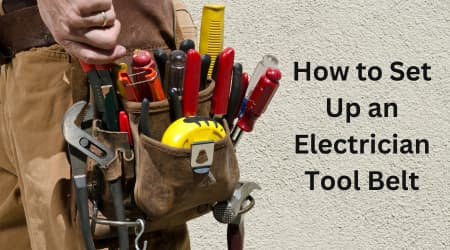
To set up an electrician tool belt, gather necessary tools and select a sturdy and comfortable belt. Then, arrange tools according to frequency of use and accessibility.
Having a well-organized tool belt is essential for electricians to have all necessary tools within reach while working on a job site. A properly equipped tool belt can help electricians work more efficiently, saving both time and effort. However, choosing the right tools and arranging them on a comfortable and sturdy belt can be a daunting task for any electrician.
In this article, we will discuss the steps required to set up an electrician tool belt to ensure it is built for maximum convenience and efficiency.
Understanding Your Tools
Different Types Of Tools An Electrician May Need
As an electrician, you'll come across a wide range of wiring systems you'll be working with. You'll also come across various conductors, wires, cables, and connections you must deal with. With each job, you must carry different types of tools specific to that job.
Here are some of the tools you may need:
- Pliers: Cutting, needle-nose, long-nose, and side-cutting pliers
- Screwdrivers: Phillips, flathead and nut drivers
- Wire strippers and cutters
- Tape measure and level
- Circuit tester
- Torpedo level
- Fish tape
- Drill and bits
- Hole saw
- Hammer
Importance Of Selecting The Right Tools For The Job
As an electrician, selecting the right tools for the job is crucial. Your tools are your most valuable asset, and how they are organized can make or break your workday. Having the right tool at the right time saves time, effort, and money.
The following are some reasons why it's essential to choose the right tools for the job:
- The wrong tools will waste your time.
- Having the right tools on hand ensures your safety.
- Proper tools provide accuracy.
- The right tools cut down on wasted materials.
- The correct tools make the job easier to complete.
Effective organization of your tool belt is pivotal to maintaining your productivity and efficiency on the job. As well as aiding in the growth of your electrician career. Ensuring you have the right tools for the job can make all the difference.
Choosing The Right Tool Belt
Factors To Consider When Selecting An Electrician Tool Belt
As an electrician, choosing the right tool belt is of utmost importance to ensure that you have easy access to all your tools while working on a job. Here are some important factors to consider when selecting an electrician tool belt.
- Size and fit: Make sure to select a tool belt that fits you perfectly. The belt should be adjustable to fit comfortably around your waist, not too tight or too loose. You should also consider the size of the pouches and pockets and ensure that they are large enough to hold all your necessary tools.
- Durability: You need a tool belt that is durable enough to withstand the rigors of everyday use. Look for belts made with tough and robust materials such as leather, nylon, or canvas.
- Number of pockets: The more pockets your tool belt has, the better organized you can be. However, having too many pockets can be overwhelming, and it can become difficult to keep track of where each tool is stored.
- Weight balance: A tool belt that is not properly balanced can cause pain and discomfort, leading to fatigue. Select a tool belt that distributes the weight evenly across your waist, and avoid choosing one that has a bulk of weight on one side.
- Comfort: Comfort is key since you will be wearing the tool belt for extended periods. Look for a belt with well-padded belts and pouches to prevent chafing and rubbing.
Different Types Of Tool Belts Available In The Market
Electrician tool belts come in different types to suit your preferences and needs. Here are the three most commonly used types of tool belts:
- Waist tool belts: Waist tool belts loop around your waist and are the most popular type of belt for electricians. They offer a lot of flexibility in terms of the number of pouches and clips they can have.
- Suspenders tool belts: If you have a lot of tools, or if your job puts a lot of strain on your waist, suspenders tool belts can be a more comfortable alternative. They hang from your shoulders, taking off pressure from your waist.
- Clip-on tool belts: Clip-on tool belts attach to your existing work belt and add extra storage space without the need for an entirely new system. These are best suited for those who require minimal storage space.
Read Also : Top 10 Best Electrician Tool Belts Of 2023
Materials Used For Tool Belts And Their Properties
Tool belts are constructed using a variety of materials, with each material offering distinct properties. Here are some commonly used materials for tool belts:
- Leather: Leather offers good durability, great aesthetics, comfortable feel, and an impressive lifespan. However, it comes at a higher price point compared to other materials.
- Canvas: Canvas belts are lightweight, breathable, and flexible, making them an excellent choice for hot or humid environments. However, they are less tough and not as durable as leather.
- Nylon: Nylon tool belts are affordable, lightweight, and durable. They have a more modern look and feel than leather and canvas.
- Polyester: Polyester belts are known for their water-resistance and easy to clean properties. They are also lightweight and cost-effective, but less durable and long-lasting than leather.
There is no one-size-fits-all approach when it comes to selecting an electrician tool belt. By considering the factors mentioned above, you can determine the best tool belt that meets your specific needs and enhances your workflow, while ensuring that you remain comfortable, organized, and efficient on the job.
Setting Up Your Tool Belt
How To Organize Your Tools For Easy Access
One of the most critical aspects of setting up your tool belt is organizing your tools in a way that allows for easy access. A disorganized tool belt can result in frustration and lost productivity. Here are some tips for arranging your tools for easy access:
- Place frequently used tools in easy to reach spots, such as the pockets located at the front of the tool belt.
- Arrange tools according to their size and weight to ensure that you don't place heavy tools alongside lighter ones.
- Keep sharp objects, such as pliers or wire cutters, in a designated pocket or holder to prevent accidental injuries.
- Store large or bulky tools, such as drills or hammers, on tool loops or clips.
Tips On Managing Weight Distribution And Balance On The Tool Belt
Another consideration when setting up your tool belt is managing weight distribution and balance. A poorly balanced tool belt can cause undue stress, resulting in fatigue or even injury. Here are some tips for managing weight distribution and balance on your tool belt:
- Balance the weight of your tools by arranging larger, heavier tools either side of the belt. This will help you maintain balance and avoid any discomfort due to uneven weight distribution.
- If you notice that your tool belt is causing discomfort on one side, adjust the weight distribution or shift tools to balance the weight more evenly.
- Choose a belt that contains enough pockets to distribute the weight of your tools. This will help prevent added stress on one specific area of your body.
- Make use of suspenders, which can be used to distribute the weight of your tool belt more evenly across your shoulders and torso.
Importance Of Regularly Reviewing And Updating Your Tool Belt
It's essential to periodically review and update your tool belt to ensure that it remains organized and efficient. An outdated or disorganized tool belt can lead to lost productivity, delays, and even injury. Here are some important reasons why you should regularly review and update your tool belt:
- Ensure that your tool belt still meets your needs by assessing the tools you use most often. You might find that certain tools are no longer needed or that new tools should be added to your kit.
- Regularly cleaning and organizing your tool belt can help you stay productive and efficient by ensuring your tools are easily accessible.
- As you gain experience as an electrician, you might find that certain tools become more or less important. Reviewing your tool belt regularly can help you stay up-to-date with changes in your field.
- Regularly reviewing your tool belt helps prevent injuries or accidents, as you can inspect each tool for wear and tear and ensure that sharp objects are stored safely.
Remember, setting up an electrician tool belt requires careful consideration of organization, distribution, and maintenance. By following these tips, you can ensure that your tool belt remains efficient, productive, and safe.
Maintenance And Care Of Your Tool Belt
Best Practices For Cleaning And Maintaining Your Tool Belt
Maintaining and cleaning your tool belt is essential to ensure that it lasts for years and is always ready when you need it. Here are some best practices to follow:
- Cloth material: Use a damp cloth to clean the dirt off of your tool belt. For stubborn stains, use a mild detergent and warm water. Make sure to not soak the tool belt as it may damage the fabric.
- Leather material: Use a leather cleaner to wipe away any dirt or stains. Use a conditioner to keep the leather soft and supple.
- Avoid harsh chemicals: Do not use bleach, ammonia, or any harsh chemicals to clean your tool belt. These chemicals can cause the material to break down, leading to a weaker and less durable tool belt.
- Let it dry: After cleaning, make sure that your tool belt is completely dry before storing it. You can air dry it or use a fan to speed up the process.
- Proper storage: Store your tool belt in a clean and dry place. Avoid storing it in a humid or damp environment, as it may cause mold to grow on the fabric or leather.
Tips On Avoiding Wear And Tear And Prolonging The Life Of Your Tool Belt
Tool belts go through a lot of wear and tear, but with proper care and attention, you can make them last longer. Here are some tips to avoid wear and tear:
- Don’t overload: Overloading your tool belt can cause the fabric or leather to stretch and weaken. Make sure to only carry the tools you need.
- Avoid sharp edges: Avoid tools with sharp edges as they can cut through the fabric or leather, leading to tears and holes.
- Use protective layers: If you’re going to be carrying sharp tools, use a protective layer like a sheath or case to prevent any damage to your tool belt.
- Don't drag: Dragging your tool belt on the ground or rough surfaces can cause it to wear out quickly. Pick it up when moving to another area.
- Regular inspection: Regularly inspect your tool belt for any signs of damage. If you see any tears, holes or worn out areas, repair them immediately before they get any worse.
Importance Of Regularly Inspecting And Testing Your Tools And Equipment
Your tools are the most important part of your work, so it's important to regularly inspect and test them. Here’s why:
- Safety: Regular inspections ensure that your tools are safe to use. Damaged tools can cause accidents or injuries.
- Prevent breakdowns: Regular inspections help you identify any potential issues, such as wear and tear on your tools or equipment, before they lead to a larger and expensive breakdown.
- Maintain efficiency: Regular inspections allow you to identify tools that are losing efficiency, so you can re-sharpen, lubricate or clean them to maintain their performance.
- Increase tool lifespan: Regular inspections and maintenance help to prolong the life of your tools and equipment.
- Save money: By detecting and repairing smaller issues before they become bigger ones, you save money on costly replacements.
By following these best practices, you can maintain, care for and prolong the life of your tool belt and tools, making sure they are always ready when you need them.
Frequently Asked Questions Of How To Set Up An Electrician Tool Belt
What Tools Should Be Included In An Electrician Tool Belt?
An electrician's tool belt should have a lineman's plier, needle-nose pliers, wire strippers, a wire cutter, a voltage detector, and screwdrivers of various sizes.
Can I Use A Regular Tool Belt For Electrical Work?
It's not recommended as regular tool belts don't have the specialized compartments and loop holders found in electrician tool belts.
Should I Invest In A Higher Quality Tool Belt For Electrician Work?
Yes, a higher quality tool belt will last longer and keep your tools organized, making your job easier and safer.
How Should I Organize My Electrician Tool Belt?
Group similar tools together and arrange them according to how often you use them. Keep the most important tools in easy to reach compartments.
How Can I Maintain My Electrician Tool Belt?
Clean it regularly and take care when handling sharp, pointed, or heavy tools to prevent damage. Always store it in a dry place.
Conclusion
As you can see, setting up an electrician tool belt efficiently requires a bit of thinking and strategizing. However, the benefits of having a well-organized and easily accessible tool belt cannot be overstated. It helps electricians work more efficiently, saves time and effort, and ensures that the right tool is always at hand.
By following the steps outlined in this article, you can effectively set up an electrician tool belt that meets your specific needs. Remember to choose quality tools and accessories, prioritize organization and accessibility, and constantly refine and adjust your setup as needed.
With these tips, you can enjoy a streamlined tool belt that enhances your work experience and boosts your productivity.





